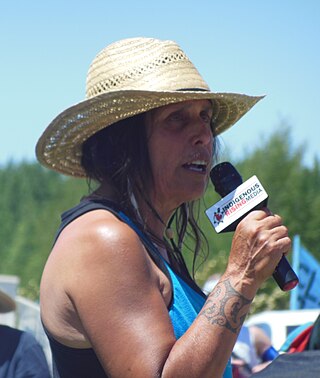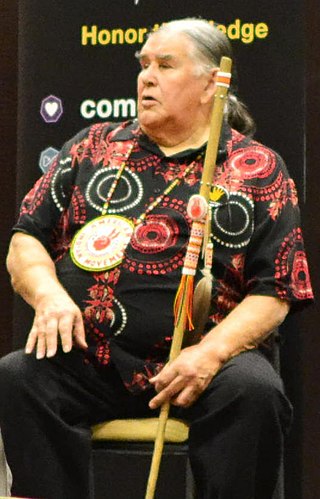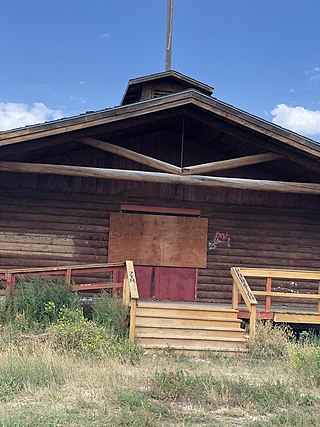
The Lakota are a Native American people. Also known as the Teton Sioux, they are one of the three prominent subcultures of the Sioux people, with the Eastern Dakota (Santee) and Western Dakota (Wičhíyena). Their current lands are in North and South Dakota. They speak Lakȟótiyapi—the Lakota language, the westernmost of three closely related languages that belong to the Siouan language family.

Winona LaDuke is an American economist, environmentalist, writer and industrial hemp grower, known for her work on tribal land claims and preservation, as well as sustainable development.

The American Indian Movement (AIM) is an American Indian grassroots movement which was founded in Minneapolis, Minnesota in July 1968, initially centered in urban areas in order to address systemic issues of poverty, discrimination, and police brutality against American Indians. AIM soon widened its focus from urban issues to many Indigenous Tribal issues that American Indian groups have faced due to settler colonialism in the Americas. These issues have included treaty rights, high rates of unemployment, the lack of American Indian subjects in education, and the preservation of Indigenous cultures.

The Pine Ridge Indian Reservation, also called Pine Ridge Agency, is an Oglala Lakota Indian reservation located in the U.S. state of South Dakota, with a small portion of it extending into Nebraska. Originally included within the territory of the Great Sioux Reservation, Pine Ridge was created by the Act of March 2, 1889, 25 Stat. 888. in the southwest corner of South Dakota on the Nebraska border. It consists of 3,468.85 sq mi (8,984 km2) of land area and is one of the largest reservations in the United States.

An American Indian reservation is an area of land held and governed by a U.S. federal government-recognized Native American tribal nation, whose government is autonomous, subject to regulations passed by the United States Congress and administered by the United States Bureau of Indian Affairs, and not to the U.S. state government in which it is located. Some of the country's 574 federally recognized tribes govern more than one of the 326 Indian reservations in the United States, while some share reservations, and others have no reservation at all. Historical piecemeal land allocations under the Dawes Act facilitated sales to non–Native Americans, resulting in some reservations becoming severely fragmented, with pieces of tribal and privately held land being treated as separate enclaves. This jumble of private and public real estate creates significant administrative, political, and legal difficulties.

Russell Charles Means was an Oglala Lakota activist for the rights of Native Americans, libertarian political activist, actor, musician and writer. He became a prominent member of the American Indian Movement (AIM) after joining the organization in 1968 and helped organize notable events that attracted national and international media coverage.

Dennis Banks was a Native American activist, teacher, and author. He was a longtime leader of the American Indian Movement, which he co-founded in Minneapolis, Minnesota in 1968 to represent urban Indians. He was a pre-eminent spokesman for Native Americans. His protests won government concessions and created national attention and sympathy for the oppression and deplorable endemic social and economic conditions for Native Americans.

Clyde Howard Bellecourt was a Native American civil rights organizer. His Ojibwe name is Nee-gon-we-way-we-dun, which means "Thunder Before the Storm". He founded the American Indian Movement (AIM) in Minneapolis, Minnesota, in 1968 with Dennis Banks, Eddie Benton-Banai, and George Mitchell. His elder brother, Vernon Bellecourt, was also active in the movement.

Annie Mae Aquash was a First Nations activist and Mi'kmaq tribal member from Nova Scotia, Canada. Aquash moved to Boston in the 1960s and joined other First Nations and Indigenous Americans focused on education and resistance, and police brutality against urban Indigenous peoples. She was part of the American Indian Movement, participated in several occupations, and participated in the 1973 Wounded Knee incident at the Pine Ridge Indian Reservation, United States.

The Wounded Knee Occupation, also known as Second Wounded Knee, began on February 27, 1973, when approximately 200 Oglala Lakota and followers of the American Indian Movement (AIM) seized and occupied the town of Wounded Knee, South Dakota, United States, on the Pine Ridge Indian Reservation. The protest followed the failure of an effort of the Oglala Sioux Civil Rights Organization (OSCRO) to use impeachment to remove tribal president Richard Wilson, whom they accused of corruption and abuse of opponents. Additionally, protesters criticized the United States government's failure to fulfill treaties with Native American people and demanded the reopening of treaty negotiations to hopefully arrive at fair and equitable treatment of Native Americans.

The Red Power movement was a social movement led by Native American youth to demand self-determination for Native Americans in the United States. Organizations that were part of the Red Power Movement include the American Indian Movement (AIM) and the National Indian Youth Council (NIYC). This movement sought the rights for Native Americans to make policies and programs for themselves while maintaining and controlling their own land and resources. The Red Power movement took a confrontational and civil disobedience approach to inciting change in United States to Native American affairs compared to using negotiations and settlements, which national Native American groups such as National Congress of American Indians had before. Red Power centered around mass action, militant action, and unified action.

The Oglala are one of the seven subtribes of the Lakota people who, along with the Dakota, make up the Očhéthi Šakówiŋ. A majority of the Oglala live on the Pine Ridge Indian Reservation in South Dakota, the eighth-largest Native American reservation in the United States.

Uranium mining and the Navajo people began in 1944 in northeastern Arizona, northwestern New Mexico, and southeastern Utah.
Madonna Thunder Hawk is a Native American civil rights activist best known as a member and leader in the American Indian Movement (AIM), co-founding Women of All Red Nations (WARN) and the Black Hills Alliance, and as an organizer against the Dakota Access Pipeline. She established the Wasagiya Najin Grandmothers' Group on the Cheyenne River to help build kinship networks while also developing Simply Smiles Children Village. She also serves as the Director of Grassroots Organizing for the Red Road Institute. Thunderhawk has spoken around the world as a delegate to the United Nations and is currently the Lakota People's Law Project principal and Tribal liaison. She was an international Indian Treaty Council delegate to the United Nations Human Rights Commission in Geneva. Also, a delegate to the U.N. Decade of Women Conference in Mexico City and in the 2001 to the World Conference against Racism in Durban, South Africa.
Sherrill Elizabeth Tekatsitsiakawa “Katsi”Cook is a Mohawk Native American midwife, environmentalist, Native American rights activist, and women's health advocate. She is best known for her environmental justice and reproductive health research in her home community, the Mohawk Nation at Akwesasne in upstate New York.
Lorelei DeCora Means is a Native American nurse and civil rights activist. She is best known for her role in the second siege in the town of Wounded Knee, South Dakota, on the Pine Ridge Indian Reservation. She was also a co-founder of the American Indian organization, Women of All Red Nations.
John Graham is a Canadian, Yukoner, Champagne and Aishihik First Nations citizen, and former Native American activist. He is best known for being convicted for the murder of fellow American Indian Movement activist Anna Mae Aquash.
Charon Virginia Asetoyer is a Comanche activist and women's health advocate. Asetoyer is one of the founders of the Native American Community Board (NACB) and the Native American Women's Health Education Resource Center (NAWHERC). President Clinton appointed her to the National Advisory Council for Health and Human Services (HHS). She has been awarded the Woman of Vision award by the Ms. Foundation and the United Nations Distinguished Services Award.
David Archambault II is the former (2013–2017) tribal chairman of the Standing Rock Indian Reservation in North Dakota. He was instrumental in the Dakota Access Pipeline protests and continues to work to promote an understanding of the historical treaty rights and indigenous rights of Native American people. Archambault holds degrees in Business Administration and Management. In 2017 he joined FirstNation HealthCare as its chief consulting officer.
Marie Elena Brady Sanchez, was an American Cheyenne, Chief Judge of the Northern Cheyenne Tribe, a human rights activist for indigenous people and a linguist.












